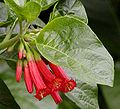Kamëntšá people
 Chaquira (=‘beaded’) mask used in the folk rituals of the indigenous Kamëntšá people of Colombia | |
| Total population | |
|---|---|
| 4,020 (2007)[1] | |
| Regions with significant populations | |
| Languages | |
| Camsá, Inga, Spanish[1] | |
| Religion | |
| Traditional tribal religion (Shamanism), Roman Catholicism (syncretized) | |
| Related ethnic groups | |
| Inga people |
The Kamëntšá people are indigenous people of Colombia. They primarily live in the Sibundoy Valley of the Putumayo Department in the south of Colombia.[3]
Name
The name is rendered variously as Kamëntšá, Camsá, Camëntsëá, Coche, Kamemtxa, Kamsa, Kamse, Sibundoy, and Sibundoy-Gaché.[1]
Language
The Kamëntšá language is a language isolate,[1] although linguists have tried to connect it to the Chibchan language family in the past. The language is written in the Latin script.[1]
Culture
They are known for their carved wooden masks that are worn during ceremonies and festivals.[3] They farm maize, beans, potatoes, and peas, and use a number of different entheogens, including ayahuasca (yagé), Brugmansia species, Iochroma fuchsioides and Desfontainia in their rituals. Kamëntšá shamans are noted for the number and variety of Brugmansia cultivars which they have propagated in their gardens of entheogenic plants, and which bear leaves in a wide variety of curiously misshapen forms. One of these cultivars - 'Culebra' ('snake' in Spanish) proved so aberrant that it was, for a time, actually removed from Brugmansia and accorded monotypic genus status as "Methysticodendron" (Greek : 'intoxicating tree'), the full Linnaean binomial of the plant becoming Methysticodendron amesianum before it was subsumed once more in Brugmansia.[4]
Gallery
Kamëntšá People
-
Kamëntšá dancers
-
Craftsperson threading traditional beadwork
-
Woodcarving of Kamëntšá in traditional costume in the Parque de Sibundoy
-
Woodcarving of Kamëntšá mythological beings, Parque de Sibundoy
-
Luis Albeiro Maldonado Monsalve, bishop of Sibundoy
Entheogenic plants of the Kamëntšá
During the long period of relative isolation, a great variety of curious cultivated plants were brought into the [Sibundoy] Valley. Some are of scant importance today and may never have enjoyed a wide appreciation among the Valley’s inhabitants. Others, the predominant food, medicinal and narcotic plants, have come to assume very great importance in the economic and social life of the natives.
Certain plants, known nowhere else, have evolved in the Valley under the influences of cultivation. Such has come to pass with the Tree Datura [=Brugmansia] drugs.[5]
Melvin L. Bristol 1969
Debasement of Sibundoy Indian culture is a sad and logical result of national development and is a model for the erosion of traditional life throughout South America. Not long ago, the Valley of Sibundoy had some of the most interesting uses of psychoactive and medicinal plants in the world. Today, alcoholism is replacing the ceremonial use of safer drugs. [6]
Andrew Weil 1980
-
Brugmansia × candida var. 'Culebra', Kew Gardens
-
Conventional form of Brugmansia × candida
-
Conventional form of Brugmansia aurea
-
Banisteriopsis caapi, principal ingredient of ayahuasca
-
Diplopterys cabrerana: jointly the most important ayahuasca additive
-
Psychotria viridis: jointly the most important ayahuasca additive
-
Seedling of Glicophyllum stylopterum (formerly known as (i.a.) Tetrapterys methystica)
-
Desfontainia spinosa: ‘borrachera del paramo’
Notable Kamëntšá people
- Hugo Jamioy Juagibioy, poet and indigenous rights activist
References
- ^ a b c d e "Camsá." Ethnologue. Retrieved 24 Nov 2013.
- ^ "Kamëntsá - Orientation." Countries and Their Cultures. Retrieved 24 Nov 2013.
- ^ a b "Arts and Crafts in Colombia." Archived 2016-05-01 at the Wayback Machine Footprint Travel Guides. Accessed 29 Jan 2014.
- ^ Schultes, Richard Evans; Hofmann, Albert (1979). The Botany and Chemistry of Hallucinogens (2nd ed.). Springfield Illinois: Charles C. Thomas
- ^ Bristol, Melvin L.,Tree Datura Drugs of the Colombian Sibundoy, Botanical Museum Leaflets Harvard University Vol. 22, No. 5, Cambridge, Massachusetts, June 13, 1969.
- ^ Weil, Andrew, The Marriage of the Sun and Moon: a quest for unity in consciousness, pub. Houghton Mifflin Company 1980 ISBN 0-395-25723-9 Chapter 11 In the Land of Yagé, p. 129.
External links
- Declaration by the Inga and Kametsa peoples, Colombia Support Network















